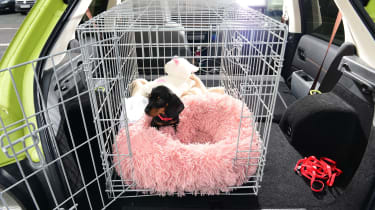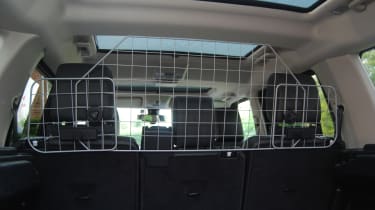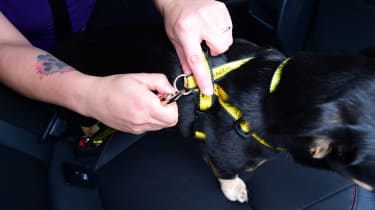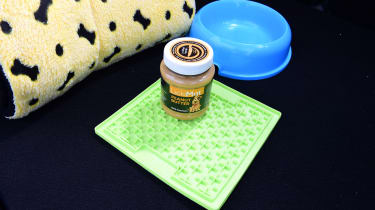In-car dog safety products: carriers, harnesses and dog guards explained
We name the best products for safely carrying your dog in the car
Whether it’s for the occasional trip to the vet or every day on the way to a favourite walking spot, you’ll need to invest in a proper way to restrain them and ensure that all occupants are safe. Besides being common sense, it’s a legal requirement. Rule 57 of the Highway Code says drivers must “make sure dogs or other animals are suitably restrained” when being carried in a car. If you fail to do so, it could be classed as careless driving, which carries a fine of up to £5,000.
There is a bewildering array of dog-restraining devices available and, unlike child seats and boosters, there are no regulations to help guide you to the safest products. They vary from full cages to simple restraints that will stop a pet climbing on the driver and distracting them, or running out into a road when a door is opened.
Not sure where to start? Here’s our guide to the pick of the products for your pups...
Dog carriers
If a crate is too cage-like or large for your car and pet, then dog carriers can be a better solution, especially for smaller breeds. These are like a big bag or box with handles, making them resemble a holdall.
They are usually made of fabric, so the carrier can be folded up when not in use, making them far easier to store. They also allow you to put your pet into the carrier before you get to the car, making it quicker and less stressful to load dogs who might be difficult to persuade to get into a vehicle.
As with crates, they can be used in the boot, but are more commonly carried in the cabin along with passengers. This means the luggage space can be used as normal.
You must secure the carrier, and the best will use a car’s Isofix points. Top choice would be the 4pets Caree carrier from roofbox.co.uk.
Dog crates
Using a dog crate at home divides opinion among owners. Many pets seem to thrive in the safe, enclosed space of a cage, while others hate it and much prefer being able to roam around.
If your pooch loves a crate then it may be the best way to keep them comfortable in a car, too. Using a cage designed for the home will keep you legal, but as a very minimum it should be secured to the car to prevent it moving. The top crates and cages will have been independently crash tested, usually bearing a mark from the German organisation TÜV. This will ensure they will not break apart in an accident, giving the best chance of protecting everyone inside the car.
There are various different sizes to cater for the size of your dog and car boot, and they must be securely fixed to the vehicle, normally using the luggage tie-down points. There are a few things to bear in mind. The first is that a crate could take up all or most of the luggage space, so your holiday suitcases would need to go elsewhere, perhaps in a roof box or trailer.
Secondly, your dog might need a dedicated ramp to access the boot, especially if they are larger. This will also help protect your car’s back bumper from getting scratched by claws.
Dog guards
If your pet is especially large, the traditional ‘dog guard’-style barrier could be the easiest way to prevent them jumping into the passenger compartment, and should also prevent them being thrown into the cabin during an accident.
Bear in mind that your car boot will need to be big enough to allow the dog to lie comfortably, and you may also wish to combine a guard with another restraint to prevent them jumping out when the tailgate is opened. This can be especially problematic in cars with electric openers, which can take longer to operate than a quick slam.
Our favourite in tests was the Mesh Headrest Dog Guard from Halfords.com, which proved rattle free and adaptable for different cars.
Dog restraints
These are the simplest and cheapest way of securing your pet inside the car. They attach via a short lead or strap to your dog’s harness and then clip into your car’s seatbelt or another anchorage point.
While any restraint will keep you on the right side of the law and should prevent your dog from distracting the driver or escaping when a door is opened, you must consider its welfare. Simply attaching a restraint to a traditional neck collar could badly hurt your pet in an accident, or even if just braking suddenly.
As a bare minimum, these restraints should only be used with a full harness, and those designed for use in vehicles are much better than those meant purely for walks. Car harnesses usually have a wider panel around the chest to spread the load in an impact, for example.
You might also want to protect the upholstery if you are putting a pooch on the seats, to prevent dirt and claw marks wrecking the interior. Newer cars have seat belt-reminder alarms that may be triggered if the dog moves off the dedicated ‘spot’ in the back. After all, they tend to be less obedient than humans.
The Best Buy from our last dog-restraint test is no longer available, so we now recommend the Sherpa Car Harness from travellingwithpets.co.uk, which has been independently crash tested and can work well on a walk, too.
Food and drink
Preparation is key to making your dog as comfortable and relaxed as possible during a car journey, because they’re going to be restrained and might not be entirely happy about it.
So, try not to feed the dog less than two hours before you hit the road, because it could induce car sickness. However, it is worthwhile making sure your dog isn’t thirsty beforehand, because this could also induce illness.
And make sure that you have a large bottle of water with you, so that you can quickly give your dog a drink should it become dehydrated.
Driving with your dog...
Find a car with the experts









